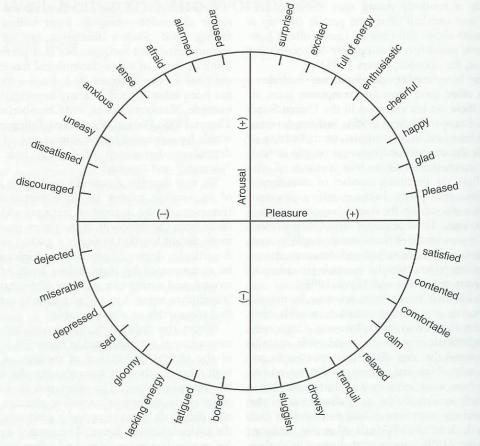Moodwall
23:30 § 1 Comment
Media architecture collective Urban Alliance has recently finished the Moodwall, a 24 meter long interactive light installation in Amsterdam. The Moodwall is situated in a pedestrian tunnel and interacts with people passing by, improving the atmosphere in the tunnel and helping to make the environment feel safer.
The interactive urban wallpaper is built out of about 2500 leds behind a ribbed semi-transparent wall.
Multimodal Experiment
23:30 § Leave a comment
In the relaxing room the seat was upholstered with a synthetic, even and flat fabric. The color of the seat was a light turquoise. The room was illuminated by using only blue fluorescent tubes in the luminaries. The illumination of the room was measured at two different spots: through the divider material (30 lux) and from above the seat (15 lux). The music played in the relaxing condition was Brian Eno’s Ikebukuro.
The stimulating room
In the stimulating room an identical round seat was used. However, the upholstery was a bright and structured red cotton. A piece of the same kind of bright and structured red cotton fabric was placed on the floor between the seat and the mirror as a mat. The illumination in the stimulating room was created by mixing red, white and blue tubes. The illumination provided through the divider material was 135 lux and above the seat 70 lux. The music in the stimulating condition was Lindsay Buckland’s Trans Amazonian Highway.
Participants and procedure
Twentyone participants (10 females and 11 males) were gathered from the various student mailing lists within the Helsinki University of Technology. In the actual test situation the participants were asked to sit down in the room and fill in a stress monitor questionnaire.
Analysis
The participants in the relaxing room perceived their environment in an integrated way. They also paid attention to characteristics that were more of a combination of different stimuli than individual stimuli. For instance softness was often described as a result of materials, illumination and music. The participants perceived the music as being the most noticeable perceptual modality in the room.
In the stimulating room the perceptual descriptions and the focus of the participants’ attention were more concentrated on individual descriptions of a few stimuli. These stimuli were materials such as, the divider, illumination, the overall simplicity of the design and colors. The participants in the stimulating room perceived the music as being the most noticeable perceptual modality. Also colours, materials and the space divider drew their attention.
The laboratory conditions with surveillance systems, used in this experiment, could be more useful in other research paths, which could also be beneficial for the development of AMDE. The hybrid method should be applied to gain more knowledge concerning single modalities, e.g. sound, luminance, colours, materials and their interaction in more strictly determined environments.
Stress and Therapy
23:30 § Leave a comment
Music Therapy
There has recently been a considerable interest in the therapeutic potential of music. A neurological study involving subjects connected to an electroencephalograph (EEG device) while listening to slowtempo music revealed that the musical rhythm quickly synchronized brain rhythms to its beat an effect also seen with strobe lights.
Colour Therapy
Exposure to coloured light is another technique for promoting relaxation. Colour therapy has been traced back to ancient Egypt, where patients at a healing temple were treated in rooms designed to break up the sun’s rays into colours of the spectrum. I
Colour Research
23:30 § Leave a comment
Walltherapy began in April 2003 and was a collaboration between Rachel Wingfield and flour aiming to bring together areas of design with neuroscience and colour science. This is essentially a research project aimed at developing a new design methodology for bespoke, end-user created designs that can have a positive effect on their environment.
Walltherapy enables everyone to create their own highly individual personal environment from their psychophysically determined colour preferences to suit and possibly enhance people’s sense of well-being. It is well established in scientific literature that ambient colour, light and texture can affect mood and behaviour this is why a conventional decorative surface, such as wallpaper has been chosen as the interface for this experiment.





